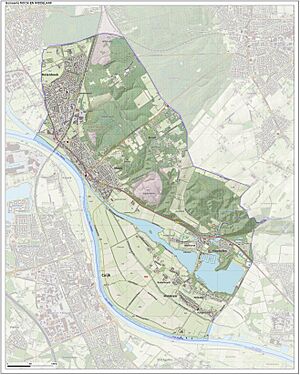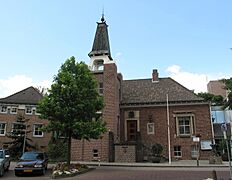Mook en Middelaar facts for kids
Quick facts for kids
Mook en Middelaar
Mook en Middelar
|
|||
|---|---|---|---|

Mook town centre across the Meuse
|
|||
|
|||

Location in Limburg
|
|||
| Country | Netherlands | ||
| Province | Limburg | ||
| Government | |||
| • Body | Municipal council | ||
| Area | |||
| • Total | 18.81 km2 (7.26 sq mi) | ||
| • Land | 17.39 km2 (6.71 sq mi) | ||
| • Water | 1.42 km2 (0.55 sq mi) | ||
| Elevation | 12 m (39 ft) | ||
| Population
(May 2014)
|
|||
| • Total | 7,773 | ||
| • Density | 447/km2 (1,160/sq mi) | ||
| Time zone | UTC+1 (CET) | ||
| • Summer (DST) | UTC+2 (CEST) | ||
| Postcode |
6584–6587
|
||
| Area code | 024 | ||
Mook en Middelaar is a small area in the southeastern part of the Netherlands. It's located at the northern tip of the Limburg province. This area is about 100 kilometers away from Maastricht, which is the capital city of Limburg. The total area of Mook en Middelaar is about 18.81 km2 (7.26 sq mi), and a part of this is water.
Contents
About Mook en Middelaar
This municipality is known for its beautiful, hilly landscape. These hills were formed a very long time ago, about 160,000 years ago, during the last ice age.
Towns and Villages
Mook en Middelaar is made up of several smaller towns and villages. These include:
- Middelaar
- Molenhoek
- Mook
- Plasmolen
A Look Back: History of Mook en Middelaar
The area of Mook en Middelaar has a long and interesting history, with discoveries from ancient times and important battles.
Ancient Times
People have lived in this area for many centuries.
Roman Discoveries
In a place called Plasmolen, people found the remains of an old Roman villa. This house was built around the 2nd century AD. Also, near the Meuse river, parts of a Roman bridge from the 4th century were discovered. These findings show that Romans were once active here.
Battles and Defenses
The region has seen several important historical events, especially battles.
The Battle of Mookerheide
The Mookerheide, a heathland near Mook, was the site of a famous battle in 1574. This battle was part of the Eighty Years War, a long conflict in the Netherlands. During this fight, Spanish forces defeated the rebel army.
Old Fortifications
To protect the area, two defense structures called the Mookerschans and Heumense schans were built. These were likely created in the 17th century. One of these, the Mookerheideschans, has been restored. It now offers amazing views over the Meuse river valley.
Modern History
More recently, the area played a role in major world events.
World War II Impact
During the Second World War, Mook en Middelaar experienced tough fighting. In May 1940, large bunkers on the other side of the Meuse river stopped enemy forces. The railway bridge between Mook and Katwijk was also destroyed.
In September 1944, Mook, Plasmolen, and Middelaar became a front-line area. This meant there was a lot of fighting, and many houses were damaged. Allied soldiers worked to secure the Heumen bridge, which was important for Operation Market Garden. The fighting was so intense that the village was liberated, then taken back by enemy forces, and then liberated again. Many soldiers who died in this area during the war are buried at the Mook War Cemetery. Most people living in Mook and Middelaar left their homes for safety until the area was fully freed.
The Mookerplassen Lakes
To help the cement industry, sand was dug from fields next to the Meuse river. This digging created the Mookerplassen, which are now popular lakes for recreation. After some floods in the 1980s and 1990s, a special movable lock was built to protect the area from future flooding.
Getting Around
Mook and the surrounding area have good public transport options. There are three bus lines that serve the municipality. It also has its own train station, called Mook-Molenhoek railway station.
Famous People from Mook en Middelaar
Several notable people have come from Mook en Middelaar:
- Karel Martens (born 1939) is a graphic designer known for his work with typography (the art of arranging type).
- Serge Daan (1940–2018) was a scientist who studied chronobiology, which is about how living things keep track of time.
- Arjen Teeuwissen (born 1971) is an equestrian (horse rider) who won a silver medal at the 2000 Summer Olympics.
- Marko Koers (born 1972) is a retired middle-distance runner. He competed in three Olympic Games starting in 1992.
Gallery
See also
 In Spanish: Mook en Middelaar para niños
In Spanish: Mook en Middelaar para niños













